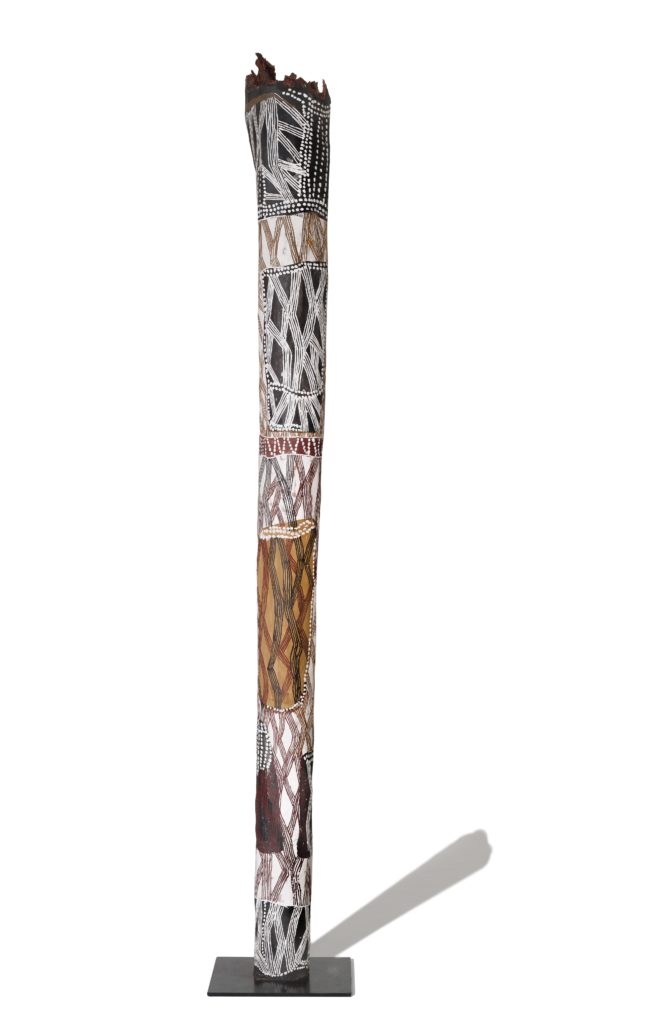Last month, in anticipation of a June 7 breakfast talk by the brilliant and mellifluous Gus Casely-Hayford, new director of the Smithsonian National Museum of African Art, I wrote in The Georgetowner’s Summer Arts Preview about Europe’s relationship to traditional African art.
Without realizing it, I was setting the stage for the Phillips Collection’s current exhibition, “Marking the Infinite: Contemporary Women Artists from Aboriginal Australia,” on view through Sept. 9.
Here’s the thing: Over the past 30 years, and particularly in the last decade, the world has opened up. With the internet and smartphones, both of which are now accessible across vast global and economic territories, we have undergone a democratization of information at an unfathomable speed and scope. (Last year, while waiting out a passing storm beneath a tree, I spent the afternoon with a poor local villager in the jungles of central Java, who pulled out his Samsung so we could communicate through Google Translate.)
Meanwhile, traditional artists and craftspeople from non-Western nations are sought after for their seemingly unbroken connections to ancient and exotic lineages — a world where paint is mixed from river clay and brushes are built from the plucked hairs and whittled bones of last season’s hunt — in an era where that sort of authenticity is increasingly rare.
So what becomes of the artistic integrity of once-isolated tribal communities when they get connected to the modern world? It is impossible to unsee or unlearn, to disconnect oneself from new ideas and possibilities.
In communities throughout Australia, aboriginal women artists are advancing this dialogue in subtle and profound new ways. Their efforts are now on dazzling display at the Phillips.
“Marking the Infinite” features works by nine leading aboriginal women artists. The subject matter of their art is broad, yet each work is an attempt to grapple with fundamental questions of existence and modernity, asking us to slow down and pay attention to the natural world. These are marks made upon an “ancient endless infinity,” revealing humanity’s insignificance against the steady movement of time and the cosmos.
The art may look traditional, but it is nothing if not of the present.
The large-scale canvases of Angelina Pwerle and Regina Pilawuk Wilson offer unique visions of a shared indigenous heritage.
Born in 1948, Wilson began her career as a weaver. In 1973, she left the Catholic mission where she had lived since childhood to establish an aboriginal community with her husband on Australia’s northern central coast. She began painting only in 2002, and wasmet with immediate acclaim. The patterns in her paintings, which at first glance look like giant web-like textiles, mimic the stitch and weave of the “syaw,” large cylindrical fishnets made from bush vine. With the imposition of missionary life, knowledge of how to make the nets had nearly vanished, and Wilson attempts to revitalize these lost traditions through her paintings.
There is an unmistakable resemblance to midcentury American minimalists in her works, recalling the static hush of Agnes Martin and the more delicate linear forms of Sol LeWitt.
On the other hand, the paintings of Pwerle, who was born around 1946, conjure galaxy clouds and dense forests. Painstakingly stippled white constellations over black and red foundations, they are inspired by the bush plum, a native plant that produces small edible berries. Traditional narratives around the bush plum are crucial to local women’s ceremonies and intertwined with the sacredness of Pwerle’s country, speaking not only to physical nourishment but also to spiritual sustenance.
Both artists create seemingly endless tapestries through their work that suggest the profound connection between the individual, the community and the universe. Other artists, however, use more traditional materials to express similar associations between indigenous traditions and modernity.
Gulumbu Yunupingu, born around 1943, is one of the most acclaimed contemporary bark painters working today. Her stunning clay-toned patterns on tree bark, painted with earth pigments and inspired by “infinite reaches of space,” recall the patterns of Islamic art and architecture, similarly meant to suggest an extension to infinity. The warped, out-of-square bark panels serve as powerful canvases against the clean walls of a gallery.
The larrakitj poles by Nonggirrnga Marawili, born around 1939, are a site to behold: skewed eucalyptus trunks, patterned with earth pigments, in freestanding clusters like crooked, sinewy gods huddled in the center of the main gallery. Stripped of bark, their smooth, knotted surfaces are decorated with geometric detail.
Hollow through the center, the tree trunks were traditionally used to store the bones of the dead, guiding them to their spiritual home. While Marawili alludes to the visual conventions of this ceremonial practice, she ultimately creates her own interpretations and, in doing so, forges a connection between her ancestral forces and her new world identity.
It is almost clichéd to say that, by far, the most interesting contemporary art getting made today is coming from places outside of the European tradition. Every time I encounter an exhibition like this I am reminded of why: the testimonies of thousands of years of traditional culture and history are rooted in this work, and it collides with staggering intellectual, visual and spiritual force with the turbulence of our modern era. The impact is what moves us into the future.


